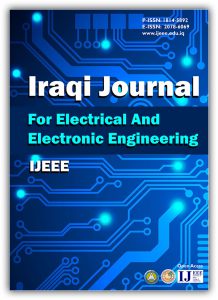
December 2015
<Previous Issue Next Issue>
![]() Open Access
Open Access
| Quarter Car Active Suspension System Control Using PID Controller tuned by PSO |
| Wissam H. Al-Mutar, Turki Y. Abdalla |
| Pages: 151-158 |
| DOI: 10.37917/ijeee.11.2.1 |
| FULL TEXT (PDF) |
| Abstract: |
|
The objective of this paper is to design an efficient control scheme for car suspension system. The purpose of suspension system in vehicles is to get more comfortable riding and good handling with road vibrations. A nonlinear hydraulic actuator is connected to passive suspension system in parallel with damper. The Particles Swarm Optimization is used to tune a PID controller for active suspension system. The designed controller is applied for quarter car suspension system and result is compared with passive suspension system model and input road profile. Simulation results show good performance for the designed controller. |
| Pro-active Self healing – An Extension Concept in Smart Grid |
| Noman Nisar, Jay Panchal |
| Pages: 159-164 |
| DOI: 10.37917/ijeee.11.2.2 |
| FULL TEXT (PDF) |
| Abstract: |
|
The reliability of power system under fault susceptible environment has become major challenge for the power sector units. The injection of renewable power source has increased the complexity for distribution system and to deal with massive network, evolution of smart-grid has been enforced, which works in an automated fashion to improve overall reliability, efficiency and quality of the system. Proactive Self-healing is a critical feature of smart-grid. This paper tries to explain the concept sensing the occurrence of fault beforehand and providing possible solution for self-healing in smart grid. The fundamental base for incorporating afore discussed technology viz. understanding nature of fault, sources of fault and implementation of effective measuring techniques are enumerated in paper briefly. Support required in terms of technology is reviewed towards the end followed by a case study of practical implementation of self-healing control in a distribution system. |
| Design and Implementation Model for Linearization Sensor Characteristic by FPAA |
| Alaa Abdul Hussein Salman, Fadhil Rahma Tahir, Mofeed Turky Rashid |
| Pages: 165-173 |
| DOI: 10.37917/ijeee.11.2.3 |
| FULL TEXT (PDF) |
| Abstract: |
|
Linearization sensors characteristics becomes very interest field for researchers due to the importance in enhance the system performance, measurement accuracy, system design simplicity (hardware and software), reduce system cost, ..etc. in this paper, two approaches has been introduced in order to linearize the sensor characteristics; first is signal condition circuit based on lock up table (LUT) which this method performed for linearize NTC sensor characteristic. Second is ratiometric measurement equation which this method performed for linearize LVDT sensor characteristic. The proposed methods has been simulated by MATLAB, and then implemented by using Anadigm AN221E04 Field Programmable Analog Array (FPAA) development kit which several experiments performed in order to improve the performance of these approaches. |
| Fuzzy Transmission Power Control Scheme for Maximizing Lifetime in Wireless Sensor Networks |
| Safaa Khudair Leabi, Turki Younis Abdalla |
| Pages: 174-182 |
| DOI: 10.37917/ijeee.11.2.4 |
| FULL TEXT (PDF) |
| Abstract: |
|
Energy limitations have become fundamental challenge for designing WSNs. Network lifetime is the most interested and important metric in WSNs. Many works have been developed for prolonging networks lifetime, in which one of the important work is the control of transmission power. This paper proposes a new fuzzy transmission power control technique that operate together with routing protocols for prolonging WSNs lifetime. Dijkstra shortest path routing is considered as the main routing protocol in this work. This paper mainly focuses on transmission power control scheme for prolonging WSNs lifetime. A performance comparison is depicted for maximum and controlled transmission power. Simulation results show an increase in network lifetime equals to 3.4776 for the proposed fuzzy control. The performance of the proposed fuzzy control technique involves a good improvement and contribution in the field of prolonging networks lifetime by using transmission power control. |
| PID Controller Based Multiple (Master/Slaves) Permanent Magnet Synchronous Motors Speed Control |
| Suroor M. Dawood, Samar H. Majeed, Habeeb J. Nekad |
| Pages: 183-192 |
| DOI: 10.37917/ijeee.11.2.5 |
| FULL TEXT (PDF) |
| Abstract: |
|
This paper suggests the use of the traditional proportional-integral-derivative (PID) controller to control the speed of multi Permanent Magnet Synchronous Motors (PMSMs). The PMSMs are commonly used in industrial applications due to their high steady state torque, high power, high efficiency, low inertia and simple control of their drives compared to the other motors drives. In the present study a mathematical model of three phase four poles PMSM is given and simulated. The closed loop speed control for this type of motors with voltage source inverter and abc to dq blocks are designed. The multi (Master/Slaves approach) method is proposed for PMSMs. Mathwork’s Matlab/Simulink software package is selected to implement this model. The simulation results have illustrated that this control method can control the multi PMSMs successfully and give better performance. |
| Different Techniques for Calculating Apparent and Incremental Inductances using Finite Element Method |
| Amer Mejbel Ali |
| Pages: 193-201 |
| DOI: 10.37917/ijeee.11.2.6 |
| FULL TEXT (PDF) |
| Abstract: |
|
This work focuses on using two-dimensional finite element method to calculate apparent and incremental inductances for 40W fluorescent lamp ballast with different loading conditions based on its design documents. Seven inductance calculation techniques are adopted by calculating ballast stored magnetic energy and flux linkage using ANSYS software. The calculated results for apparent inductances show a good agreement with the design and average measured values, while calculated incremental inductances have been verified by noting the behavior of core hysteresis loop experimentally. These seven techniques establish a good base for researchers and designers to obtain an accurate inductance profile for any iron-core inductor. |